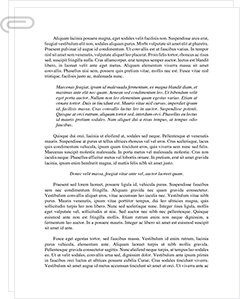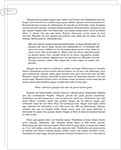 Study Document
Study Document
Health Insurance Analysis Essay
Pages:7 (1885 words)
Document Type:Essay
Document:#533620
Essay Topic Examples
1.Health Insurance Coverage Disparities:
Analyze how different demographic groups experience varying levels of health insurance coverage, exploring the reasons behind these disparities and their implications on health outcomes.
2.The Impact of Health Insurance on Healthcare Quality:
Examine how the presence or absence of health insurance affects the quality of healthcare services received, including access to preventive care, specialist consultations, and treatment options.
3.Economic Analysis of Health Insurance Models:
Compare and contrast different health insurance models (e.g., single-payer, private insurance, employer-sponsored) in terms of cost-effectiveness, consumer satisfaction, and economic impact on both individuals and the healthcare system.
4.Legislative Changes and Health Insurance:
Investigate how recent legislative changes have influenced health insurance policies, coverage, and consumer rights, focusing on laws like the Affordable Care Act or similar reforms in other countries.
5.Technology and Health Insurance:
Explore how technological advancements like AI, blockchain, and telemedicine are reshaping health insurance practices, from claims processing to personalized insurance plans.
Essay Title Examples
1.Navigating the Maze: Understanding Health Insurance Coverage
2.The Economics of Health: A Deep Dive into Insurance Models
3.Health Insurance and Equity: Bridging the Gap
4.Legislation's Role in Shaping Health Insurance
5.Technology's Transformative Impact on Health Insurance
Essay Hook Examples
1.Imagine a world where your health is not just a matter of personal care but a financial gamble.
2.Every year, millions are denied the healthcare they need due to insurance coverage issues.
3.What if your health insurance could predict your health needs before you even know them?
4.In the game of health insurance, not all players start with the same cards.
5.The cost of healthcare is rising, but is health insurance keeping pace?
Thesis Statement Examples
1.Health insurance disparities significantly contribute to unequal health outcomes, necessitating policy interventions to ensure equitable access to healthcare services.
2.The quality of healthcare services is directly influenced by the type of health insurance coverage, with comprehensive plans leading to better health outcomes and preventive care.
3.Economic analysis reveals that while single-payer systems might reduce administrative costs, private insurance models offer flexibility and choice, impacting consumer satisfaction and economic efficiency differently.
4.Recent legislative changes have both expanded and restricted health insurance coverage, affecting millions of lives and highlighting the need for continuous policy evaluation and adjustment.
5.Technological innovations are poised to revolutionize health insurance by enhancing efficiency, reducing fraud, and personalizing coverage, thereby potentially improving overall healthcare delivery.
Essay Outline Examples
I. Introduction
Background on Health Insurance
Definition and purpose of health insurance
Historical context of health insurance development
Thesis Statement
Statement of the main argument or perspective
Overview of the essay's structure
II. Body
Health Insurance Coverage Disparities
Analysis of demographic data on insurance coverage
Discussion on the implications for health equity
Impact of Health Insurance on Healthcare Quality
Case studies showing correlation between insurance and care quality
Expert opinions on the role of insurance in healthcare delivery
Economic Analysis of Health Insurance Models
Comparison of cost structures in different insurance models
Consumer satisfaction and economic implications
III. Conclusion
Summary of Key Points
Recap of the main findings from the analysis
Implications for policy and future research
Call to Action
Encouragement for policy reform
Advocacy for consumer education on health insurance
Essay Introduction Examples
Introduction Paragraph 1
Health insurance, a critical component of modern healthcare systems, serves as a financial safety net, ensuring that individuals can access medical services without facing prohibitive costs. Originating in the late 19th century, health insurance has evolved from a luxury to a necessity, influenced by economic, social, and political factors. Today, it stands at the intersection of public policy, economics, and personal health, with its analysis revealing much about societal values and economic structures. This essay delves into the multifaceted world of health insurance, exploring how different models of insurance coverage impact healthcare quality, economic efficiency, and social equity. By examining the disparities in coverage, the economic implications of various insurance models, and the influence of legislative changes, we aim to understand the broader implications of health insurance on both individual lives and the healthcare system at large.
Introduction Paragraph 2
The landscape of health insurance is as diverse as the populations it serves, with each model offering unique benefits and challenges. From single-payer systems to private insurance, the structure of health insurance can dictate not only the financial aspect of healthcare but also the quality and accessibility of medical services. This analysis will explore how these different insurance frameworks affect healthcare delivery, focusing on the economic implications, consumer satisfaction, and the overarching goal of health equity. By dissecting the economic models, legislative impacts, and technological advancements in health insurance, this essay seeks to provide a comprehensive view of how health insurance shapes healthcare outcomes and what this means for policy development and individual health management.
Essay Body Examples
Paragraph 1
Health insurance coverage disparities are starkly evident across different demographic groups, with factors like income, race, and employment status playing significant roles. For instance, lower-income families often find themselves underinsured or uninsured due to the high cost of premiums, leading to delayed or foregone medical care. This not…
…1
In conclusion, the analysis of health insurance reveals a complex interplay between economic models, legislative frameworks, and societal values. The disparities in coverage, the impact on healthcare quality, and the economic implications of different insurance models underscore the need for a balanced approach to health insurance policy. While no single model is perfect, the evidence suggests that a combination of public oversight with private sector innovation could lead to more equitable and efficient health insurance systems. Moving forward, policymakers must consider not only the financial aspects but also the social justice implications of health insurance, striving for a system where health care is accessible to all, regardless of economic status or background.
Conclusion 2
As we reflect on the multifaceted nature of health insurance, it becomes clear that its role extends beyond mere financial protection. Health insurance is a determinant of health equity, economic stability, and societal well-being. The insights from this analysis call for a proactive approach in policy-making, where health insurance reforms are not just about cost but about ensuring that every individual has the opportunity to lead a healthy life. The future of health insurance lies in leveraging technology, understanding economic models, and fostering legislative environments that prioritize health as a fundamental human right. This essay has highlighted the need for continuous dialogue, research, and action to refine health insurance systems, ensuring they serve the needs of all citizens effectively.
In-Text Citation Examples
In-Text Citation Examples
In-text citation examples:
1. According to the National Health Interview Survey, the uninsured rate among adults aged 18-64 was 12.6% in 2020 (National Health Interview Survey).
2. The Medical Expenditure Panel Survey indicates that out-of-pocket health care expenses have been steadily increasing over the past decade (Medical Expenditure Panel Survey).
3. Data from the Health Insurance Coverage report shows a slight decrease in the number of uninsured children from 2019 to 2020 (Health Insurance Coverage).
4. The Kaiser Family Foundation's analysis reveals that the percentage of the population covered by private health insurance varies significantly by state (Kaiser Family Foundation).
Sources Used:
1. National Health Interview Survey
2. Medical Expenditure Panel Survey
3. Health Insurance Coverage: Early Release of Estimates from the National Health Interview Survey
4. Kaiser Family Foundation's Health Insurance Coverage of the Total Population
Primary Sources
National Health Interview Survey (NHIS)
MLA Citation: "National Health Interview Survey." Centers for Disease Control and Prevention, U.S. Department of Health & Human Services, www.cdc.gov/nchs/nhis/index.htm. Accessed insert date.
Medical Expenditure Panel Survey (MEPS)
MLA Citation: "Medical Expenditure Panel Survey." Agency for Healthcare Research and Quality, U.S. Department of Health & Human Services, www.meps.ahrq.gov/mepsweb/. Accessed insert date.
Health Insurance Coverage: Early Release of Estimates from the National Health Interview Survey
MLA Citation: "Health Insurance Coverage: Early Release of Estimates from the National Health Interview Survey." Centers for Disease Control and Prevention, U.S. Department of Health & Human Services, www.cdc.gov/nchs/data/nhis/earlyrelease/insur202105.pdf. Accessed insert date.
Kaiser Family Foundation's Health Insurance Coverage of the Total Population
MLA Citation: "Health Insurance Coverage of the Total Population." Kaiser Family Foundation, www.kff.org/other/state-indicator/total-population/?currentTimeframe=0&sortModel=%7B%22colId%22:%22Location%22,%22sort%22:%22asc%22%7D. Accessed insert date.
Current Population Survey (CPS) Annual Social and Economic Supplement (ASEC)
MLA Citation: "Current Population Survey (CPS) - Annual Social and Economic Supplement (ASEC)." U.S. Census Bureau, www.census.gov/programs-surveys/cps/data-detail.. Accessed insert date.
Related Documents
 Study Document
Study Document
Health Insurance Analysis
1. The Impact of Health Insurance on Access to Healthcare: Examine how health insurance coverage affects individuals' ability to access medical services, preventive care, and manage chronic diseases. Discuss socio-economic factors that influence health insurance coverage and explore the ripple effects on community health and well-being. 2. Health Insurance Policy Analysis: Comparing International Models: Analyze different health insurance models around the globe, comparing the systems in countries like the United States,
 Study Document
Study Document
Health Insurance in the U.S.: Health Insurance
Health Insurance in the U.S.: Health insurance has become an important part in the modern health care system even before the American government started to discuss the issue of compulsory medical insurance. Actually health insurance has asserted itself through the ever-increasing number of customers seeking for these services as well as through advertisements. The new customers tend to share information on the benefits of health insurance with their friends. This in
 Study Document
Study Document
Health Insurance Portability and Accountability Act HIPAA
Health Insurance Portability and Accountability Act (HIPAA) Discuss whether there has been a violation of Health Insurance Portability and Accountability Act (HIPAA)? There are no court rulings that can shed light on the issue. However going by the given facts, it is as follows: "Dr. Williams shows Joan's medical records to a friend for advice. His friend tells Dr. Williams to contact his medical malpractice insurance carrier." The problem here is if
 Study Document
Study Document
Health Policy Analysis: Nursing &
" (Jacobs and Skocpol, 2007) Brown and Sparer (2003) state that Medicare is "...administered by the federal government. Not only eligibility criteria and financing policy but also the benefit package, policies governing payments to providers, and decisions about the delivery system (for instance, fee-for-service vs. managed care) are determined in Washington, D.C., with no direct participation by the states. (the program delegates important decisions about coverage and payments to third-party insurers
 Study Document
Study Document
Health Insurance for the Less
Healthy Connections Kids (HCK) is a non-Medicaid administered care program for children up to age nineteen in South Carolina, who do not have other insurance coverage and whose family unit earnings is less than two hundred percent of the federal poverty limit. HCK benefits are founded on the state health plan benefits. Kids covered under this program must be enrolled in one of the Managed Care Organizations (MCO's) who provide
 Study Document
Study Document
Healthcare Analysis of Newspaper Research
(Health Insurance Coverage, 2009). This is just a little higher than what was reported in the state of Pennsylvania over the last two-year period, which was at 25% (Krawczeniuk, 2009). "The number of uninsured rose 2.2 million between 2005 and 2006 and has increased by almost 8 million people since 2000" (Health Insurance Coverage, 2009). Most Americans are provided with health insurance coverage through their employers. But in today's society




